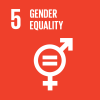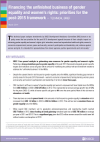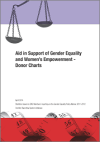FOUND 16 RESULTS
2018 marked the first year gender equality was featured as part of the main Financing for Development (FFD) Forum programme. An expert session brought together three leading experts to review trends in financing for gender equality and explore options to increase fiscal space at the national and local level.
The Government of Andalusia has presented, as part of its 2018 Budget Bill, its Gender Impact Assessment Report. The report is an ex ante evaluation of the resources that the Government of Andalusia allocates to the promotion of gender equality. The Report, together with G + Program and Gender Budgeting Audits, are the main elements of the Gender Budgeting strategy in the Andalusian region.
A recent blog by UN Women presents analysis and lessons from the 2018 monitoring round for SDG Indicator 5.c.1, shedding light on government efforts to design and implement gender budget tracking systems. Data from 69 countries show that despite global progress in adopting gender budgeting, gaps persist in the implementation of policies and laws on gender equality and women’s empowerment. Less than half of the reporting countries indicated having adequate resource allocations...
UN Women Training Centre has opened registration to the Gender Responsive Budgeting (GRB) course in Spanish. It will take place in Santo Domingo, Dominican Republic, from 18 to 23 February 2018 at the UN Women Training Centre. All interested governmental policymakers and development practitioners are encouraged to complete the application form by 31 January 2018.
Sustainable Development Goal (SDG) Indicator 5.c.1 “Proportion of countries with systems to track and make public allocations for gender equality and women’s empowerment” has been recently reclassified as Tier II by the Inter-Agency Expert Group on SDGs. The indicator measures progress towards Target 5c of the SDGs to “adopt and strengthen sound policies and enforceable legislation for the promotion of gender equality and the empowerment of all women and girls at all levels”. It links the policy and legal requirements for gender equality with resource allocations for their implementation. By tracking resource allocations, governments introduce deliberate measures into the planning and budgeting cycle to meet their gender policy objectives such as eliminating gender based violence or increasing women’s employment. By making these allocations public, governments commit to higher levels of transparency and accountability in budget decision making.
Paper discussing the definition and measurement of Sustainable Development Goal (SDG) Indicator 5.c.1 (reclassified to Tier II) and discussing the relationship of SDG Indicator 5.c.1 with other Indicators.
This note provides an overview of existing gender equality markers and reviews issues relating to the tracking and monitoring of investments related to gender equality and women’s empowerment. It is intended as an input into the development of a guidance note for the UN system on principles and standards for the design, implementation and reporting systems on investments that support gender equality and women’s empowerment in the UN system.
This technical paper analyses investments by OECD Development Assistance Committee (DAC) donors in six policy areas that are priorities for the...
This toolkit follows the transfer of public funds from central to local governments until they reach users such as schools and clinics. It explains how a public expenditure tracking system operates and how it can benefit marginalized groups. With this toolkit local communities can track the inputs, outputs, and outcomes of particular government services, and determine the gender-specific distribution of benefits from those services.
The guidance note sets out commom principles and standards for gender equality markers systems that track and report on allocations and expenditures for gender equality and women's empowerment.






